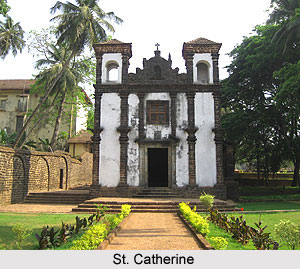 St. Catherine is located in Goa to the west of the Church of St. Francis of Assisi. The church is built of laterite blocks and has a tower on both the sides of the facade. The interior of the chapel has only one plain altar.
St. Catherine is located in Goa to the west of the Church of St. Francis of Assisi. The church is built of laterite blocks and has a tower on both the sides of the facade. The interior of the chapel has only one plain altar.
Construction of St. Catherine
The chapel of St. Catherine was rebuilt in 1552 on the relics of the former structure which built in 1510. The church was earlier built by Alfonso de Albuquerque to commemorate his victory when he took possession of Goan territory on St. Catherine`s Day in 1510. The chapel was enlarged in 1550 by the Governor George Cabral. In the chapel he carved a stone slab inscribing the entry of Alfonso De Albuquerque who had captured Goa from the Muslim rulers. The translation of the inscription reads as follows: `Here in this place was the doorway through which Governor Alfonso de Albuquerque entered and took this city from the Mohammadans on the day of St. Catherine in the year 1510 in whose honour and memory the Governor, George Cabral, ordered this chapel to be built in the year 1550 at the expenses of His Highness.` The chapel was thus built on the spot where earlier stood the gates of this city under the Muslim rule.
The status of this chapel was later elevated to that of a Cathedral by Pope Paul III by a papal Bill issued in 1534. Among the various other churches in Goa, the chapel of St. Catherine stands alpine because of its distinct Renaissance architectural style. There are see two towers erected on either side of the main entrance. The walls of the church are limestone and laterite plastered. The main altar of the church is beautifully gilded. The interior of the church is adorned with intricate artistic designs and art works. There are paintings displaying instances of the life of St Catherine of Alexandria. There is also an art gallery in the church that is worth visiting. The site nearby housed the Royal Hospital founded by Alfonso de Albuquerque in 1511. It was renovated in 1952.
Renovation of St. Chapel
The church of St. Chapel has been repaired and renovated by the ASI`s Mini Circle of Goa. The area surrounding the church had been levelled and walls were constructed for levelling the soil. Flights of steps were also provided at each level. Being located at a lower level, the chapel was provided with drainage along with a proper slope. A laterite pathway was provided from the entrance gate to the chapel.











